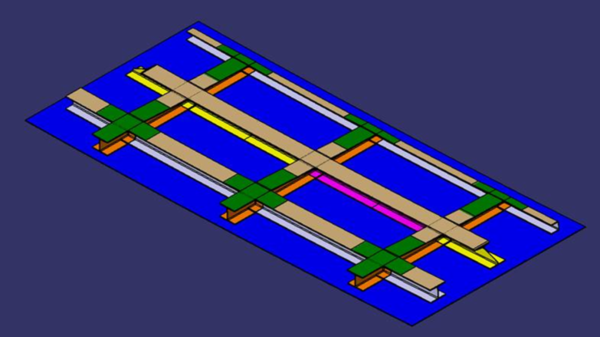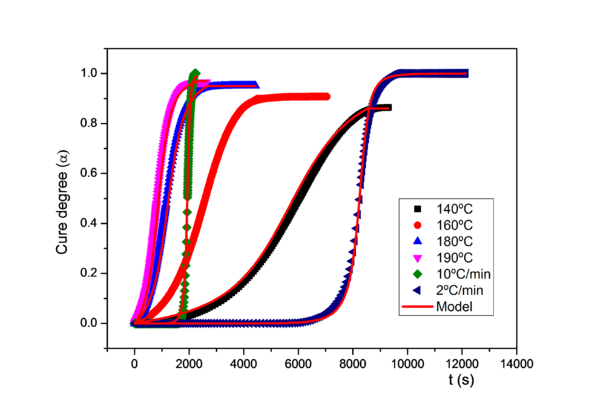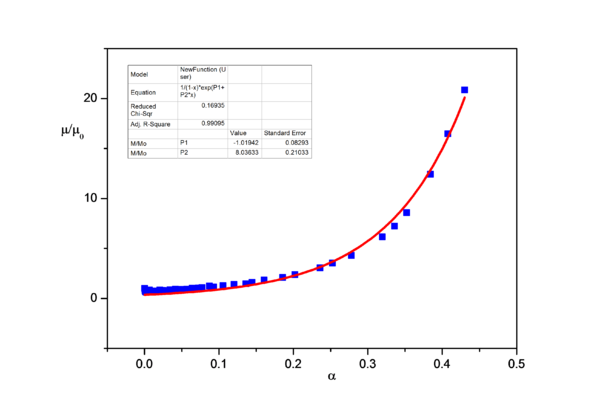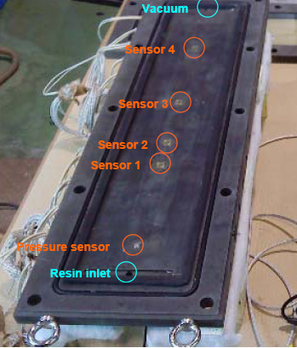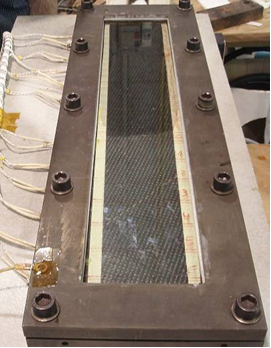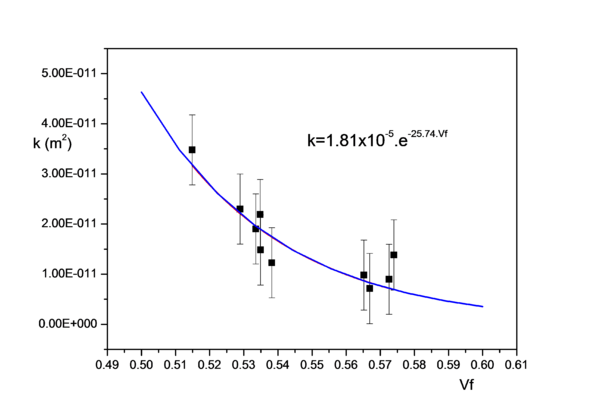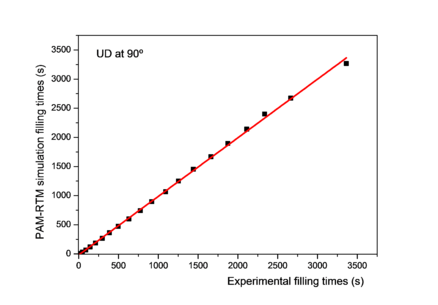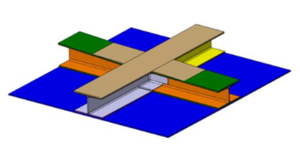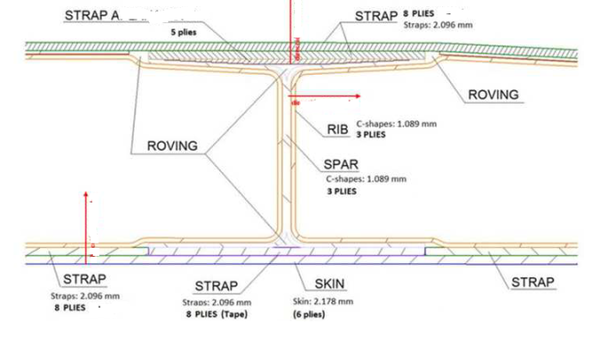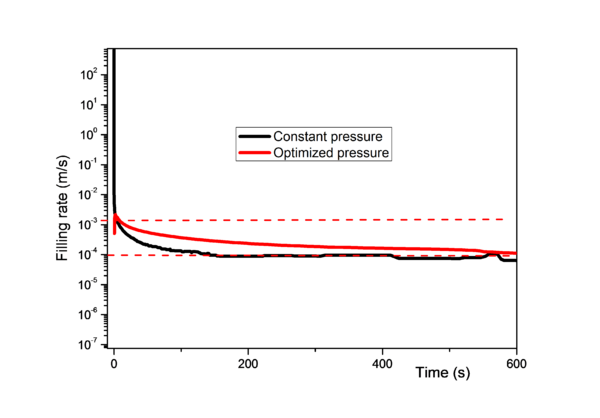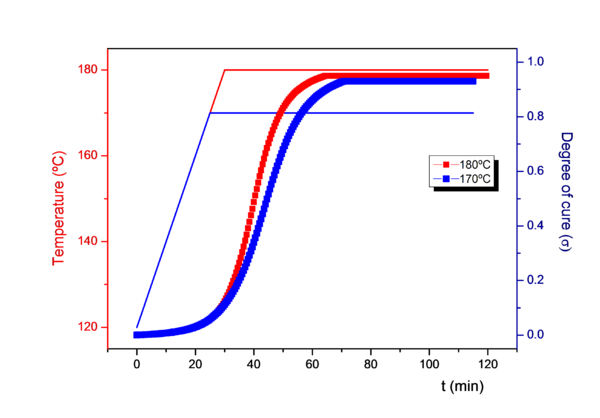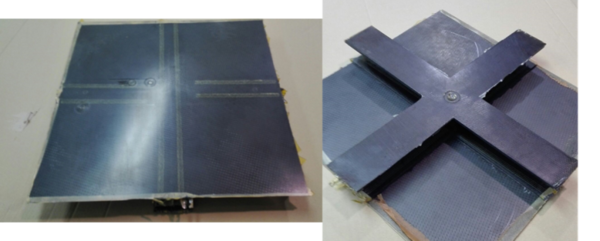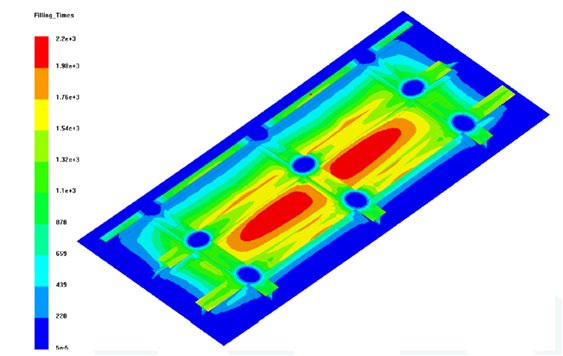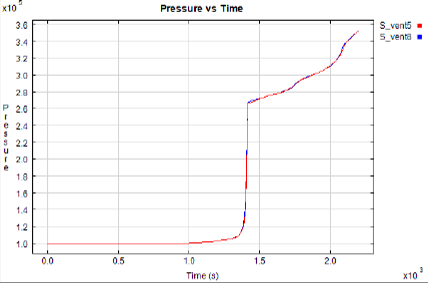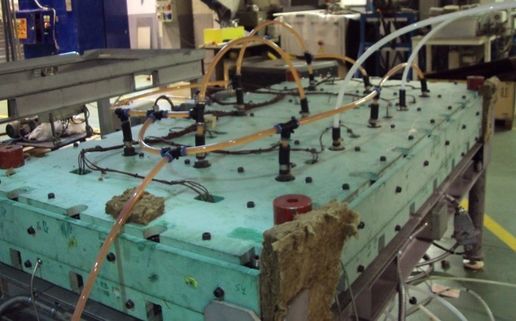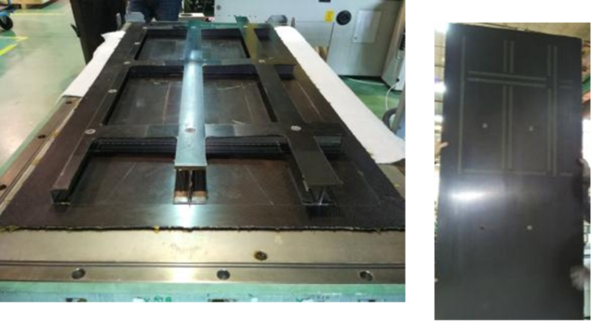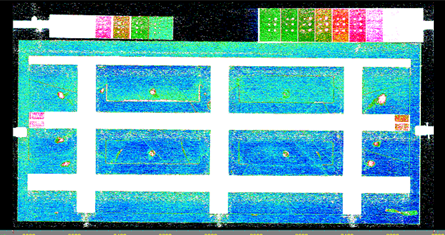1 Introduction
Resin transfer moulding (RTM) is a process well suited to meet the growing demand in the aerospace industry to produce high performance parts at a reduced cost [1-3]. This paper presents the work performed to define the processing parameters and mould for a single-shot RTM manufacturing of a highly integrated aeronautic structure based on material characterization, modelling and injection and curing simulation.
In the study the reinforcements and the resin are characterized experimentally to obtain the permeability, viscosity and curing models needed for simulating the injection and curing processes. Therefore prototype components are simulated and manufactured to compare different injection strategies and identify critical parameters as well as to validate the simulation methodology. Finally the RTM process of the complete structure is simulated and the manufacturing process is defined with proper injection parameters and injection and vent locations resulting in a successful prototype manufacturing. .
This study on the design of a single-shot RTM process is part of a collaborative project (ATEAERO) between Aernnova Group, Análisis y Simulación, Mecanoplástica, CTA and Tecnalia. The general goal of ATEAERO project is to reduce the complexity and cost of composite aerostructures.
The component selected is a 1775x800 mm aircraft door structure with a monolithic skin and double T and C stiffeners. The part is to be moulded in a one-shot RTM process with all the stiffeners integrated.
By taking an integrated approach to RTM, it has been possible to manufacture in one single step (one-shot) a highly integrated structure resulting in a lower number of parts and reduced material and manufacturing costs. In this case, injection and curing simulations play an important role in defining a robust manufacturing process and thus have a direct incidence on the development time, mould cost and part performance.
2 Materials characterization and modelling
The studied resin system is an RTM aerospace grade epoxy. The reinforcements used are an unidirectional (UD) and a 0/90 carbon fabric, both with epoxy based powder binder applied.
2.1 Rheo-kinetics
In order to perform the rheo-kinetic modelling, DSC and viscosity tests have been carried out. For this purpose, both isothermal and dynamic calorimetric tests were performed in a TA QA100 DSC. For viscosity, isothermal oscillatory tests at a frequency of 1 Hz were performed in a parallel plate rheometer, model RheoStress 6000 from Haake.
DSC results are fitted to a modified Kamal-Sourour model in order to take into account diffusion effects [4].
|
|
(1) |
Where α is the degree of cure, t the time, T the process temperature, k1, k2, E1, E2, m and n are adjustable parameters and F(α) is the diffusion function.
|
|
(2) |
Where Ec and αc are temperature dependent variables
|
|
(3) |
|
|
(4) |
Figure 2 shows the comparison between the experimental results and the model for both isothermal and dynamic conditions.
Viscosity (μ) is expressed as a function of degree of cure and temperature with a variation of Castro-Macosko equation [5].
|
|
(5) |
Where α is the degree of cure, T the process temperature, and μ0, E, p1 and p2 adjustable parameters.
Figure 3 shows the comparison between the experimental viscosity data and the master curve μ/μ0.
2.2 Permeability
The fabrics in-plane permeability has been characterized experimentally in three fiber orientations (0º, 45º and 90º) to establish the permeability tensor with the rectilinear (1D) method [6]. The tests are carried out at the RTM process temperature. Fabrics preforms a
re prepared following the prototype preforming process parameters in order to take into account the influence of the preforming pressures and temperatures on the binder distribution and resultant fabrics permeability [7].
Figure 4 shows the experimental setup used for the permeability characterization. It consists of a heated lower steel plate with integrated temperature pressure and electric sensors distributed along the length. The top of the mould has a transparent glass window in order to be able to track the flow front optically.
The permeability have been measured at different fiber volume content and the results fitted to an exponential model [8].
|
|
(6) |
Where Vf is the fiber volume content and a and b are adjustable parameters .
Figure 5 shows as an example the fitfing for the 0/90 fabric.
The obtained permeability values have been validated with a simulation of the permeability experiments with PAM-RTM. As can be seen in the figure below, there is a good correlation between the experimental and the calculated filling times.
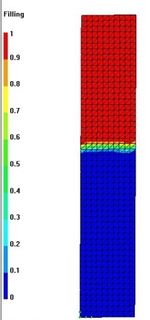
|
3 Simulation strategy definition and validation
Previous to the full component process simulation a representative section was simulated and manufactured to compare the different possible injection strategies and identify critical parameters as well as to validate the simulation methodology.
The figure bellow shows the selected structure representative section. The dimensions of the section are 400x400mm and it includes a stiffener crossover and all the different laminates existing in the aircraft door structure (Figure 8).
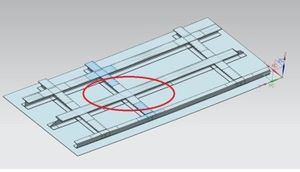
|
The different process variations (inlets and outlets locations, process boundary conditions) have been simulated with PAM-RTM taken into account the possible sources of variation such edge effects in order to select the most robust injection strategy.
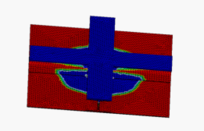
|
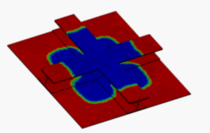
|
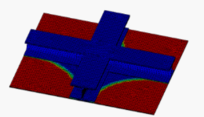
|
| STRATEGY 1 | STRATEGY 2 | STRATEGY 3 |
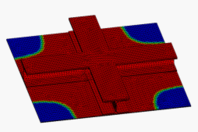
|
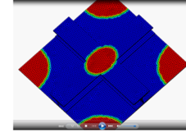
|
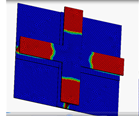
|
| STRATEGY 4 | STRATEGY 5 | STRATEGY 6 |
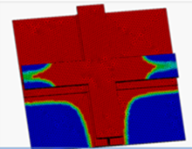
|
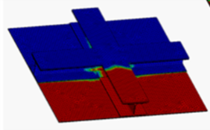
|
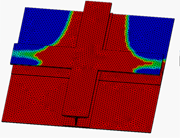
|
| STRATEGY 7 | STRATEGY 8 | STRATEGY 9 |
The results show that it is necessary to inject the resin at the top of the stiffeners to have a complete filling (strategy 4). Also, the injection at the border of both the stringer the skin (strategy 9) could reduce the injection times or pressures.
Regarding the injection parameters, the simulation results show that a linear increase of the pressure during the first 3 injection minutes could lead to a velocity profile in the recommended ranges for these fabrics to avoid macro and micro porosities (between 10-4 y 10-3 m/s) (Figure 10).
Curing is shown to be negligible during injection at 120ºC for the selected resin system at times lower than 1 hour, so viscosity can be considered constant. Regarding the curing cycle, the simulation shows that a heating rate of 2ºC/min + 1 hour at 180ºC (total time of 85 min) is enough to achieve the recommended curing degree even if the temperature of the mould is 10ºC lower than the target temperature.
Therefore the representative section was manufactured with the most promising process parameters and injection strategies in order to validate the simulations. Figure 12 shows as an example the results for the injection strategy nº9 and the recommended linear increase of pressure. As can be seen, a complete filling of the part is achieved.
4 Aircraft door structure single-shot proces simulation
Once the most promising injection strategies and parameters identified the following step has been to simulate the full aircraft door structure. The following constraints were imposed:
- Injection time lower than 1 hour
- Pressure gradient lower than 4 bars
- Inlets and outlets locations out of the mould inserts areas.
Again several injection strategies are simulated with PAM-RTM to finally select the following process parameters:
- Injection points/inlets at the 9 stiffeners crossovers and the skin perimeter
- Outlets at 6 locations
- Sensors with triggers at the outlets locations in order to close the outlets once the resin arrives
- Pressure gradient of 3 bars
- Injection temperature of 120ºC
These conditions allow to have:
- An injection time lower than 1 hour (aprox 37 min) with a pressure gradient of 3 bars
- Inlets and outlets locations out of the mould inserts areas.
- An injection strategy with low sensibility of mould assembly and preform variations.
The figures below show the filling times profile obtained in the simulation and the pressure profiles at 2 selected sensors.
5 Process validation
Finally, the full aircraft door structure was manufactured with the selected process parameters in order to validate the process. Process simulations results were also used to design the RTM mould (inlets and outlets locations and mould temperatures and pressures). The following figure shows the mould and manufacturing process.
Although the filling times of the prototype were a bit lower than expected the filling was complete. Visual and NDT inspections (Figures 16 and 17) show that a good quality is achieved.
6 Conclusions
Injection and curing simulations have been used to optimize the design of the mould and the process parameters of a single-shot RTM process of a highly integrated structure. The simulation has allow to reduce the development phase providing rapid solutions for testing the different process options Results show that the selected process parameters and injection strategy provide a good quality with an optimized process time.
Acknowledgements
Financial support of the Basque Government under contract ER 2013/00041 (ATEAERO. Nueva generación de puerta de tren de aterrizaje para futuro avión de pasillo único) of the ETORGAI program is gratefully acknowledged.
References
[1] D. Amstrong, SAMPE journal, 42, 3,.54-62 (2006).
[2] J. Loan, Composite Worfd , (2012).
http://www.compositesworld.com/articles/integrated-optimized-aircraftdoor
[3] G. Gardiner, Composite Worfd , (2013).
http://www.compositesworld.com/articles/cutting-the-cost-of-integrateddcomposite-aerostructures
[4 ] N: Rabearison, Ch.Jochum, J.C. Grandidier, Journal of Materials Science 46(3):787-796 (2011)
[5] J. M Castro, C. W. Macosko, S. J. Perry, Polymer Commun, 25, 82-95 (1984)
[6] P. Ferland,D. Guittard, F. Trochu,, Polymer Composites 17, 1, 149-158 (1996)
[7] A. Endruweit, P. McGregor, A. C. Long, M.S. Johnson, Composites Science and Technology, 66, 1778-1792 (2006)
[8] C. Demaria, PhD report (2008)
Document information
Published on 15/07/18
Accepted on 15/07/18
Submitted on 15/07/18
Volume 02 - Comunicaciones Matcomp17 (2018), Issue Núm. 3 - Reciclaje y Sostenibilidad y Procesos de Fabricación I, 2018
DOI: 10.23967/r.matcomp.2018.07.015
Licence: Other
Share this document
Keywords
claim authorship
Are you one of the authors of this document?
